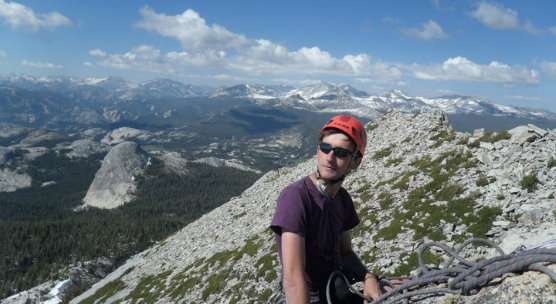Rock climbers consistently risking injury and pain to maximise performance

Rock climbers are routinely putting themselves at risk of pain and injury by wearing footwear several sizes too small for them, according to new research from the University of Dundee.
It had been known for many years that some rock climbers wore ill-fitting and excessively tight footwear during climbing activity in order to maximise performance on small grips but scant evidence existed regarding the extent or harm of this practice.
The Dundee research found that footwear deemed significantly ill-fitting was found in 55 out of 56 rock climbers. Foot pain during activity was also commonplace in 91 per cent of the climbers. A mean size reduction of almost 4 UK shoe sizes was found between the climbers' street shoe size and that of their climbing footwear. There was also a higher association of climbers of higher abilities seeking a tighter shoe fit.
The study was carried out by Ryan McHenry as part of his Intercalated BMSc (Hons) research project in Applied Orthopaedic Technology under the supervision of Professor Rami Abboud. Ryan, himself a keen rock climber, investigated footwear use in the sport with a particular focus on issues surrounding fit.
Ryan said, "We have uncovered new insights into the problems surrounding foot injury and footwear use in rock climbing. It has been shown that foot pain during rock climbing is both common and regular, and the extent to which climbers restrict their feet during activity has been quantified.
"It is clear that many climbers, particularly those of higher ability, choose shoes that are significantly smaller than their feet. Also demonstrated is a wide variation in the manufacturers sizing of climbing footwear, adding to the problems encountered by the climber wishing to purchase appropriately sized shoes. These practices inevitably lead to the wide range and high prevalence of foot pain and injury seen in participants in this study."
The resulting paper, 'Footwear in Rock Climbing: Current Practice', has been published in The Foot: the International Journal of Clinical Foot Science. It presents the possibility of further work seeking to establish the correct sizing and tolerances for safe and effective footwear in order to prevent the discomfort and injury described while maintaining performance characteristics. This, in addition to the introduction of consistent sizing, may empower the climber to choose the correct shoes.
A fully functioning artificial climbing wall with a 10° overhang was built at the University's Institute of Motion Analysis & Research (IMAR) in order to allow researchers to analyse ankle and foot movements during rock climbing and this continues to be used for current research projects.
Ryan's supervisor Professor Rami Abboud, Director of IMAR, said, "Ryan is full of energy and passion towards his favourite sport, rock climbing. Based on this, he was determined to undertake a challenging project that he designed, developed and executed to perfection which even included building the rock climbing wall at IMAR.
"I have very much enjoyed my interaction with him, firstly as an intercalated student and now as a medical doctor. I am sure Ryan will go far in his career as his passion and enthusiasm can never be dampened. This research is hoping to put a stop to the unnecessary damage to the climbers feet, which in turn affects the whole musculoskeletal system."
More information: R.D. McHenry et al. Footwear in rock climbing: Current practice, The Foot (2015). DOI: 10.1016/j.foot.2015.07.007

















